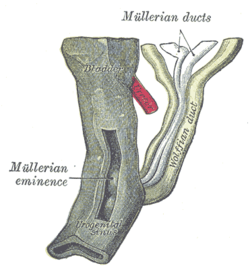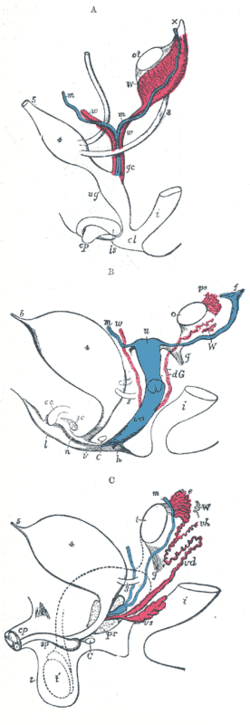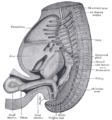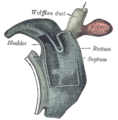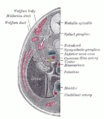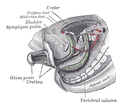- Mesonephric duct
-
Mesonephric duct Urogenital sinus of female human embryo of eight and a half to nine weeks old. Transverse section of a chick embryo of forty-five hours' incubation. Latin ductus mesonephricus; ductus Wolffi Gray's subject #252 1205 Carnegie stage 11 Days 28 Precursor intermediate mesoderm Gives rise to vas deferens, seminal vesicles, epididymis Code TE E5.6.2.0.0.0.4 The mesonephric duct (also known as Wolffian duct, archinephric duct, Leydig's duct and nephric duct) is a paired organ found in mammals including humans during embryogenesis.
It connects the primitive kidney Wolffian body (or mesonephros) to the cloaca and serves as the anlage for certain male reproductive organs.
Contents
Development
In both the male and the female the Wolffian duct develops into the trigone of urinary bladder, a part of the bladder wall. However, further development differentiates between the sexes in the development of the urinary and reproductive organs.
Male development
In a male, it develops into a system of connected organs between the efferent ducts of the testis and the prostate, namely the epididymis, the vas deferens, and the seminal vesicle. The prostate forms from the urogenital sinus and the efferent ducts form from the mesonephric tubules.
For this it is critical that the ducts are exposed to testosterone during embryogenesis. Testosterone binds to and activates androgen receptor, affecting intracellular signals and modifying the expression of numerous genes..[1]
In the mature male, the function of this system is to store and mature sperm, and provide accessory semen fluid.
Female development
In the female, in the absence of testosterone support, the Wolffian duct regresses, and inclusions may persist. The epoophoron and Skene's glands may be present. Also, lateral to the wall of the vagina a Gartner's duct or cyst could develop as a remnant.
The derivatives can be remembered using the mnemonic, "Gardener's SEED" for Gartner's duct, Seminal vesicles, Epididymis, Ejaculatory duct and Ductus deferens.[2]
History
It is named after Caspar Friedrich Wolff who described the mesonephros and its ducts in his dissertation in 1759.[3]
Additional images
See also
- Fetal genital development
- List of homologues of the human reproductive system
- Masculinization
- Müllerian duct
- Sexual differentiation
References
- ^ Hannema SE, Print CG, Charnock-Jones DS, Coleman N, Hughes IA (2006). "Changes in gene expression during Wolffian duct development". Horm. Res. 65 (4): 200–9. doi:10.1159/000092408. PMID 16567946.
- ^ "Wolffian duct: Derivatives". LifeHugger. http://mc.lifehugger.com/moc/1232/Vitelline_veins_Derivatives. Retrieved 2009-12-12.
- ^ synd/2845 at Who Named It?
External links
- Mnemonic at medicalmnemonics.com 1266
- How the Body Works / Sex Development / Sexual Differentiation / Duct Differentiation - The Hospital for Sick Children (GTA - Toronto, Ontario, Canada)
Prenatal development/mammalian embryogenesis · Development of the urinary and reproductive organs (GA 11.1204, TE E5.6-7) Common urinary and
reproductive systemUrinary system
developmentNephrotome → Pronephros · Mesonephros (Mesonephric tubules)
WD → Ureteric bud + Metanephrogenic blastema
US → Urinary bladder + Urethra + Primary urethral groove + UrachusReproductive system
developmentPrimarily internalGonadal ridge → Indifferent gonad → Gonadal cord (Cortical cords, Testis cords)
Pronephric duct/Wolffian duct/mesonephric duct + Müllerian duct/paramesonephric ducts (Vaginal plate)
US → Prostate or Skene's glandPrimarily externalLPM → Genital tubercle → Labioscrotal swelling → Scrotum or Labia majora
LPM → Genital tubercle → Primordial phallus → Penis or Clitoris
Peritoneum → Processus vaginalis or Canal of NuckHomologues Categories:- Embryology of urogenital system
Wikimedia Foundation. 2010.

